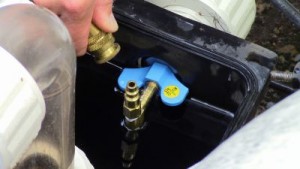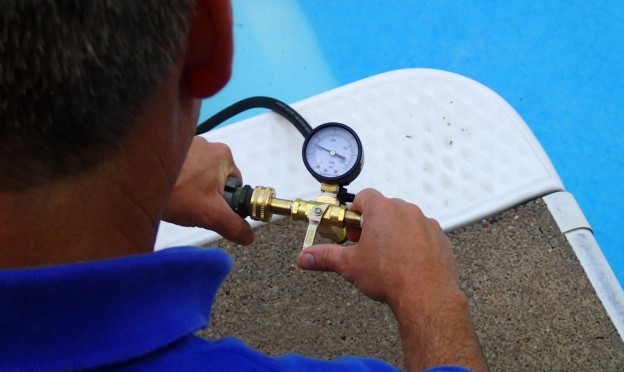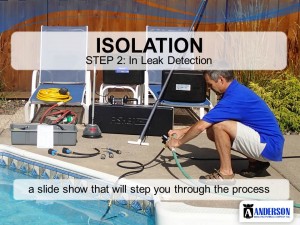Regardless of whether the leak is suspected to be in the plumbing or the structure of the pool, a pressure test should be done to provide confirmation of which parts of the pool are leaking, and which can be eliminated as suspected leak areas. This is important not only because it saves time in later leak location steps, but also because it allows the technician to provide the pool owner with the assurance that leaks have been found and fixed are isolated to the pool.
To do a pressure test, closed test plugs are used to block off all but one of the exposed openings of a section of plumbing. A pressure induction system is put in the remaining opening (usually at the equipment). Water is then induced into the line through the Pressure Tester and the system is brought up to no higher than 20 PSI. A pressure drop indicates a leak. A line that holds pressure can be eliminated as a potential leak area.
(Above is a video on how to pressure test)
While a pressure test of an entire plumbing system may be adequate in situations where a structural leak is suspected, individual sections of plumbing should be tested if a plumbing leak is suspected. Valves at the equipment can often be used to isolate these sections as they are tested first. Do so by testing from the equipment to the closed valves to see if they hold pressure (illustrated below).

Water is used for this isolation pressure test because it does not compress under pressure and as a result gives more accurate and quick results. Water is also advantageous for this test because if test pressures get higher that a safe level, plugs that pop out under water pressure will not fly from the openings as a dangerously as those that pop out under air pressure.
Accept no compromises when it comes to the sealing effectiveness of your test plugs. Tapered plugs have tendency to pop out under test pressures wasting valuable time and putting anybody in the area of the tapered plug at risk of injury. Plugs with straight-sided rubber and large corrosive resistant hardware allow for extra sealing area, easy expansion, and ultimately more accurate results.
Your pressure induction system should allow for easy access to a variety of different plumbing openings and allow the introduction of either water or air (for later leak location steps) into the plumbing. A system utilizing various sizes of open stem plugs, which can be quick-connected to the pressure tester, provides the ability to do this without having to cut lines or jerry-rig fittings. A pressure tester should include a 0-30 PSI gauge, hook ups for a garden hose and air line, a valve to control these and block off the system, as well as a means of releasing pressure from a line that has been tested but does not leak.
For additional information and a comprehensive step by step slideshow on pressure testing click below:



